Valuing ANZ's new hybrid (ANZPI)...
ANZ has finally launched their new hybrid, called Capital Notes 6, which will be traded on the ASX under the ticker ANZPI. This is ANZ’s first hybrid issue in nearly 4 years (the last being ANZ Capital Notes 5, or ANZPH, in September 2017), which is an exceptionally long gap between issues.
S&P rates major bank hybrids in the BBB- band (ie, investment-grade), and has them trending towards a possible upgrade to BBB if it lifts Australia's banking industry country risk assessment (BICRA) score, which it currently handicaps at a 1-in-3 probability over the next 2 years.
ANZPI has a first optional redemption, or repayment, date (also known as a "call date") of 20 March 2028, giving it an expected tenor of 6.7 years. Note that ANZ has provided for two additional call dates on 20 June 2028 and 20 September 2028. This allows the issuer more flexibility in timing a refinancing transaction subject to market conditions. The security is otherwise a standard Basel III hybrid, with a mandatory conversion date into ordinary ANZ shares on 20 September 2030 (ie, if it is not repaid before this date it will be converted into equity). ANZPI is expected to start trading on the ASX on the 9 July.
ANZ is offering to pay a quarterly, fully-franked, floating rate distribution based on a margin of 3.00% to 3.20% above the quarterly bank bill swap rate (BBSW). Given a very strong book-build of over $2 billion and expected sizing in the $1.25 billion range, ANZPI will price at the lower end of the proposed range (ie, 3.00%), making the yield on the security approximately 3.03%.
Fair value
At a margin of 3.00% above BBSW, ANZPI is quite cheap compared to various measures of fair value. Our internally built quant lab (see screenshot below) values the new security at a spread of about 2.86% above BBSW, or around $100.85 compared to the $100 issue price.

The closest comparable is the recently issued NAB Capital Notes 5 (ASX: NABPH), which has a call date that is roughly 3 months shorter than ANZPI. It has been trading on a spread of about 2.80% above the swap rate, implying that the new issue offers a 0.20% higher yield for a little bit extra tenor.
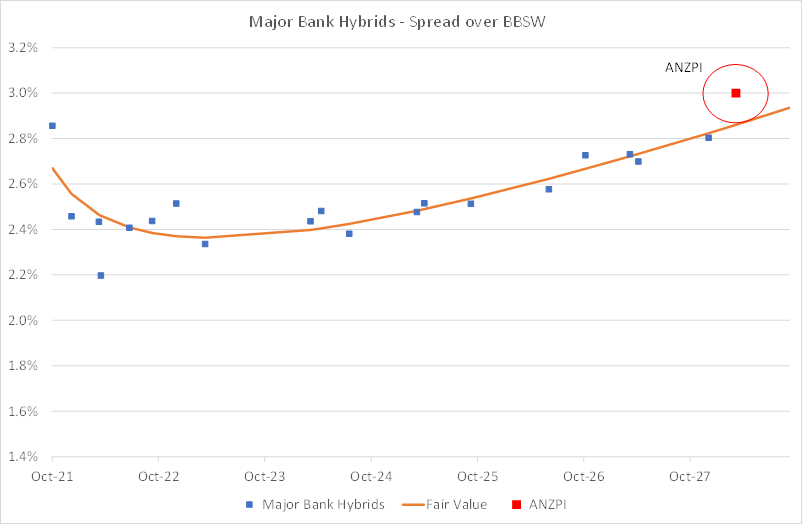
ANZPI's 3.00% credit spread also compares favourably with the most recently issued major bank hybrid, CBA PERLS XIII (ASX: CBAPJ), which only paid 2.75% above BBSW, albeit for materially less tenor.
ANZPI's spread is on the high side of the recent 2.70% to 3.00% range for a 6.7 year constant maturity major bank hybrid that has prevailed since the start of this year (see below). While on a longer time-frame ANZPI's expected 3% margin is below the average 6.7 year spread, it is conspicuously attractive for investors searching for yield in a world characterised by near-zero cash and deposit rates.
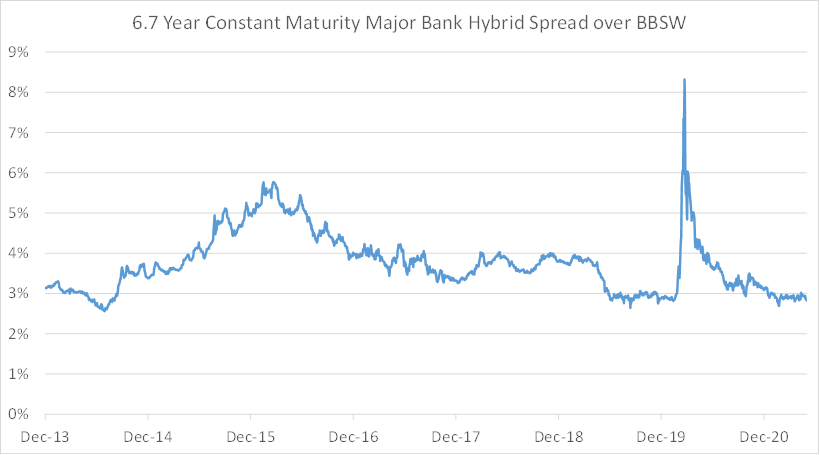
Coolabah runs valuation models that encompass all global hybrids. Using our USD model, the new security has a fair spread of 287bps above the local currency benchmark (see below).
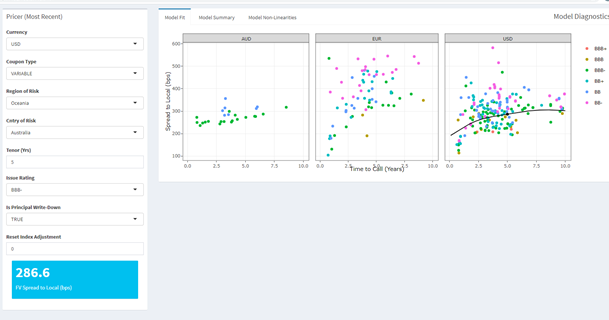
Coolabah also runs pricing models to value the option that is embedded in Basel III hybrids – if conversion to equity occurs due to an APRA declaration of non-viability or the issuer’s CET1 ratio declining below 5.125%, the hybrid holder receives less than $100 in value for their units if the issuer’s share price is more than 80% below where it was when that hybrid was issued.
Below you can see the value of this option to the issuer over time for ANZPD, the security being refinanced by ANZPI. You can see that in periods of stress when ANZ’s share price declined (like in 2016 and again in early 2020 during the COVID-19 crisis), the value of this option (contingent on conversion to equity actually occurring) rose to as much as $10.
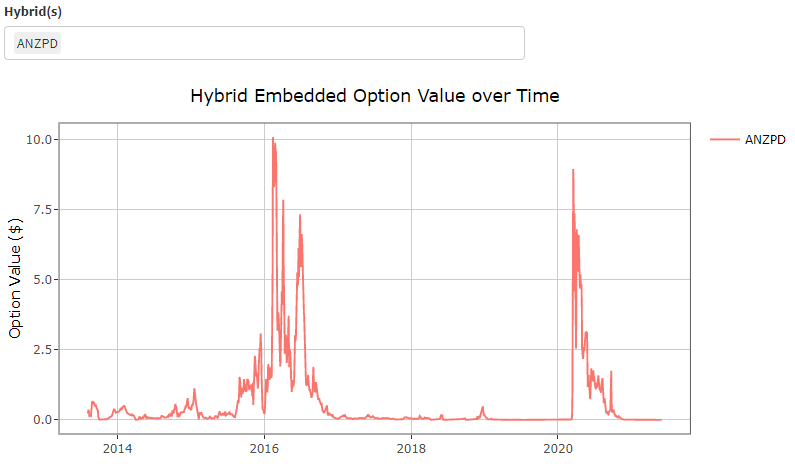
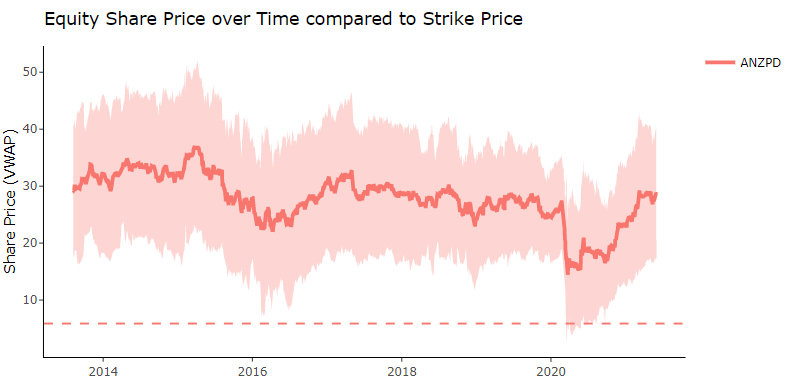
Coolabah also uses bottom-up models to determine the fair value spread of a bond given the company’s leverage and asset volatility. Below is a screenshot from this system showing a 6.7 year bond issued by ANZ, with the assumption of 0% recovery in the event of default, and a 10% probability of default – under those assumptions, the implied fair value spread over BBSW is 1.58%.
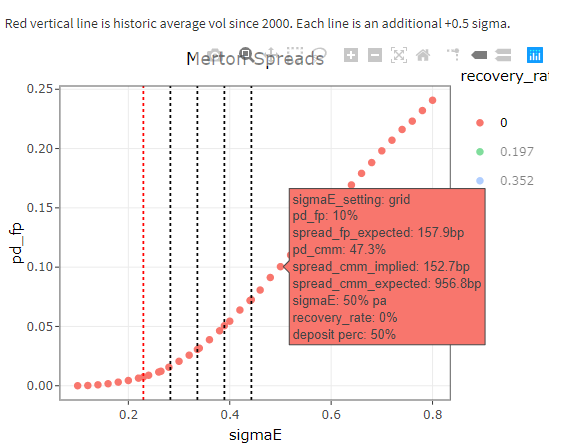
Issue size and demand
ANZ has stated that it wants to raise about $1bn for the new security. Holders of ANZ Capital Notes (ANZPD) can reinvest their holdings in ANZPI. ANZPD is a $1.12bn hybrid due to be called on 1 September this year. Given the long gap between ANZ new issues, we expect a large proportion of ANZPD holders will elect to reinvest.
While we expect ANZ to raise more than their stated $1bn, we don’t believe it will be substantially above the size of ANZPD – in other words, we expect ANZ is largely aiming to replace their maturing security rather than substantially increasing their Additional Tier 1 capital. ANZ currently has a very healthy Tier 1 ratio of 14.32%, which means they are not desperate to raise capital. They are also likely to want to keep hybrid issue sizes smaller in order to avoid large refinancing risk in the future.
This limitation on issue size and likely large percentage of reinvestment from ANZPD will serve to limit the amount of ‘new money’ available, and with the cash rate and deposit rates near zero, the likely retail demand for ANZPI will well outstrip supply.
Credit rating
The new security will have an imputed S&P credit rating of BBB- (S&P do not officially rate the retail-oriented ASX-listed hybrids, but their methodology is very clear on what the credit rating would be if they were rated), making it investment grade.
In April, S&P also revised their banking industry country risk assessment (BICRA) score trend to ‘positive,’ meaning they see a 1-in-3 possibility of an improvement within the next two years. This improvement would raise the Standalone Credit Profile (SACP) of all Australian banks, which would lead to a credit rating upgrade of major bank hybrids from BBB- to BBB. Coolabah believes the chances of such an upgrade are more like 50%-75% over the next two years.
Access Coolabah's intellectual edge
With the biggest team in investment-grade Australian fixed-income and over $6 billion in FUM, Coolabah Capital Investments publishes unique insights and research on markets and macroeconomics from around the world overlaid leveraging its 13 analysts and 5 portfolio managers. Click the ‘CONTACT’ button below to get in touch.
2 topics

